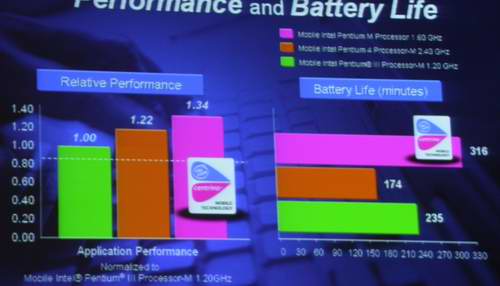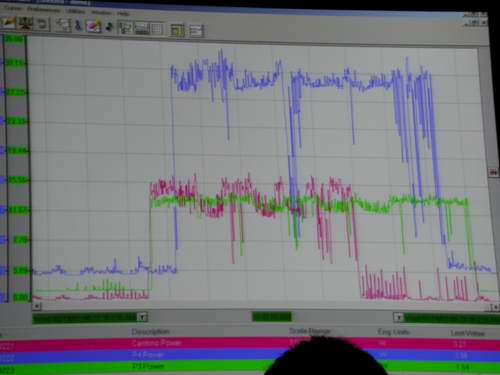Intel Developer Forum Spring 2003 - Day 2: Learn about Prescott & Centrino
by Anand Lal Shimpi on February 19, 2003 1:06 PM EST- Posted in
- Trade Shows

Intel talked a bit about the performance of the Centrino platform by comparing the following platforms: a 1.2GHz mobile Pentium III, 2.4GHz Pentium 4-M and a 1.6GHz Pentium M Centrino system.
Intel ran a series of unspecified tests on the three platforms simultaneously, all Intel informed us of was the fact that they were doing everything from Spreadsheet tasks to DVD creation tasks. It sounds to us like they did a lot of multitasking involving video encoding as well as some basic office tasks, and obviously the test was designed to show off the performance of the Pentium M processor as best as possible.
The outcome of the test was quite positive, here are Intel's official results:

The green bar is the mobile Pentium III, the orange bar is the Pentium 4-M and the pink bar is the Pentium M. As you can see, the performance of the solution is quite strong, and it effectively pushes the Pentium 4-M out of the majority of the notebook market. We still expect the Pentium 4 to remain in the absolute highest performance desktop replacement systems, but Centrino and Pentium M will occupy the majority of the other mobile segments in existence.

Intel also monitored power consumption of the three processors during the test, the results of which you can see above. The pink line represents the Pentium M, the blue and green represent the Pentium 4-M and mobile Pentium III respectively. The things to take away from this chart is that in its idle state, the 1.6GHz Pentium M consumes less power than the mobile Pentium III. The mobile Pentium III vs. Pentium M comparison is an important one to make because the two processors use very similar microarchitectures, so the higher clocked Pentium M using less power gives you an indication of exactly how beneficial the architecture enhancements to the Pentium M core are.
Under peak usage, the Pentium M does have slightly higher power consumption than the mobile Pentium III, but you'll also notice that there are points during which the Pentium M's power consumption drops a significant amount - these are points where the Pentium M's power saving technologies are kicking into effect and powering down parts of the chip or FSB that are idle, thus causing a decrease in power consumption.

Anand shows off a Tablet PC using Centrino mobile technology
Anand Chandrasekher finished up his portion of the keynote by showing off solutions from most of the major vendors, including two proud Taiwanese makers - ASUS and FIC.

Anand holding a 300mm Pentium M wafer
Anand did make a brief mention about the future of the Pentium M processor with a few words about the 90nm successor to Banias codenamed Dothan. Although much hasn't been disclosed about Dothan, we can say that it will have a massive 2MB L2 cache which is simply incredible when it comes to a mobile CPU. Dothan is due out at the beginning of 2004 and is pin compatible with the current Pentium M processor and will work in all current Centrino platforms.










0 Comments
View All Comments